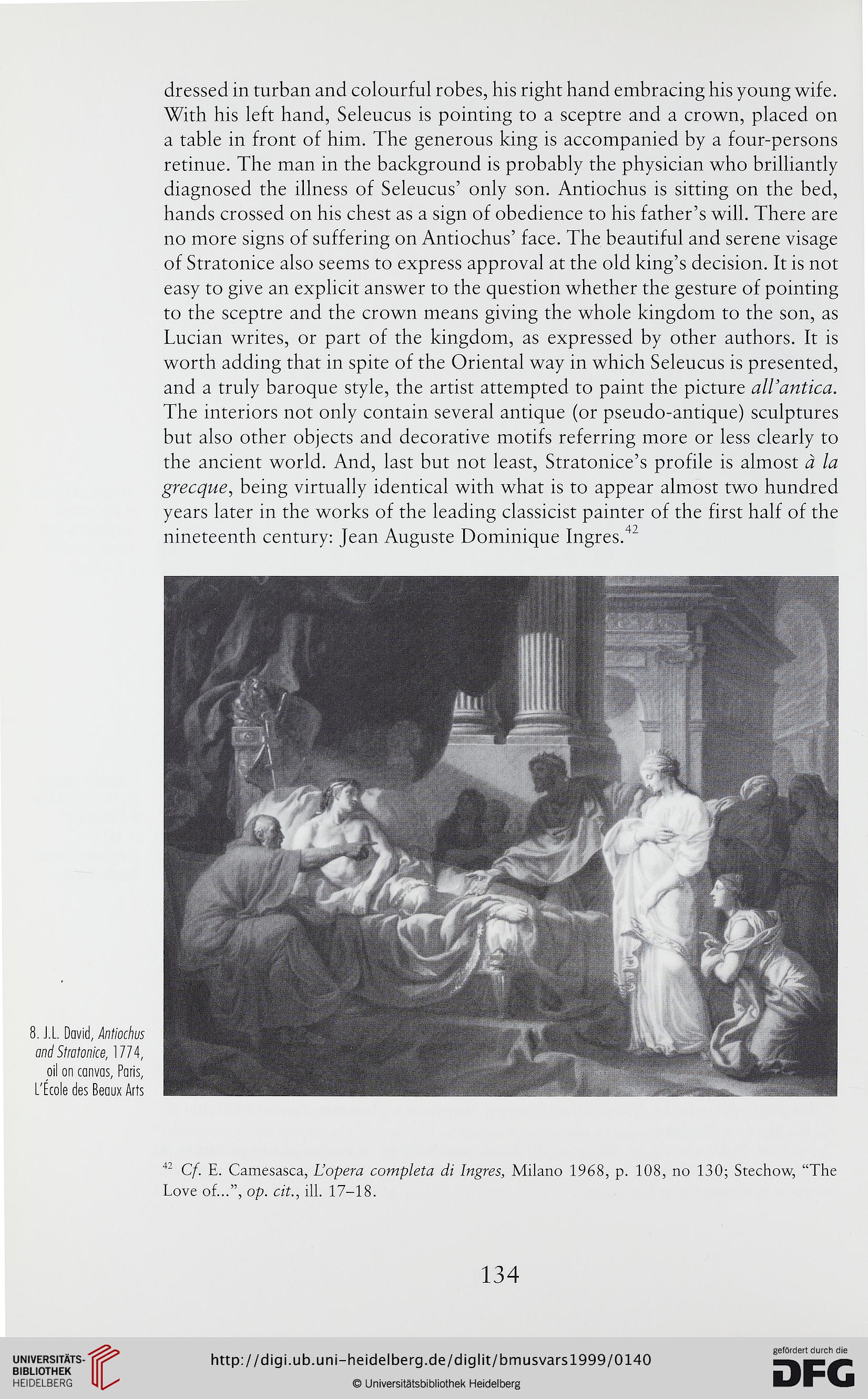dressed in turban and colourful robes, his right hand embracing his young wife.
With his left hand, Seleucus is pointing to a sceptre and a crown, placed on
a table in front of him. The generous king is accompanied by a four-persons
retmue. The man in the background is probably the physician who brilliantly
diagnosed the illness of Seleucus’ only son. Antiochus is sitting on the bed,
hands crossed on his chest as a sign of obedience to his father’s will. There are
no morę signs of suffering on Antiochus’ face. The beautiful and serene visage
of Stratonice also seems to express approval at the old king’s decision. It is not
easy to give an explicit answer to the ąuestion whether the gesture of pointing
to the sceptre and the crown means giving the whole kingdom to the son, as
Tucian writes, or part of the kingdom, as expressed by other authors. It is
worth adding that in spite of the Oriental way in which Seleucus is presented,
and a truły baroąue style, the artist attempted to paint the picture aWantica.
The interiors not only contain several antiąue (or pseudo-antiąue) sculptures
but also other objects and decorative motifs referring morę or less clearly to
the ancient world. And, last but not least, Stratonice’s profile is almost a la
grecąue, being virtually identical with what is to appear almost two hundred
years later in the works of the leading classicist painter of the first half of the
nineteenth century: Jean Augustę Dominiąue Ingres.42
8. J.L. David, Antiochus
and Stratonice, 1/74,
oil on canvas, Paris,
L'Ecole des Beaux Arts
42 Cf. E. Camesasca, Lopera completa di Ingres, Milano 1968, p. 108, no 130; Stechow, “The
Love of...”, op. cit., ill. 17-18.
134
With his left hand, Seleucus is pointing to a sceptre and a crown, placed on
a table in front of him. The generous king is accompanied by a four-persons
retmue. The man in the background is probably the physician who brilliantly
diagnosed the illness of Seleucus’ only son. Antiochus is sitting on the bed,
hands crossed on his chest as a sign of obedience to his father’s will. There are
no morę signs of suffering on Antiochus’ face. The beautiful and serene visage
of Stratonice also seems to express approval at the old king’s decision. It is not
easy to give an explicit answer to the ąuestion whether the gesture of pointing
to the sceptre and the crown means giving the whole kingdom to the son, as
Tucian writes, or part of the kingdom, as expressed by other authors. It is
worth adding that in spite of the Oriental way in which Seleucus is presented,
and a truły baroąue style, the artist attempted to paint the picture aWantica.
The interiors not only contain several antiąue (or pseudo-antiąue) sculptures
but also other objects and decorative motifs referring morę or less clearly to
the ancient world. And, last but not least, Stratonice’s profile is almost a la
grecąue, being virtually identical with what is to appear almost two hundred
years later in the works of the leading classicist painter of the first half of the
nineteenth century: Jean Augustę Dominiąue Ingres.42
8. J.L. David, Antiochus
and Stratonice, 1/74,
oil on canvas, Paris,
L'Ecole des Beaux Arts
42 Cf. E. Camesasca, Lopera completa di Ingres, Milano 1968, p. 108, no 130; Stechow, “The
Love of...”, op. cit., ill. 17-18.
134




